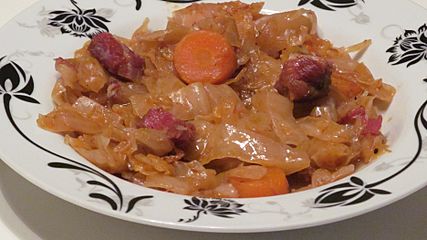Whole sour cabbage facts for kids
Whole sour cabbage is a special kind of cabbage that has been preserved. It's also known as Kiselo zelje in some countries. This food is very popular in Eastern Europe and the Balkan region.
It's a bit like sauerkraut, but there's a big difference. Instead of using shredded cabbage, whole heads of cabbage are used. This process is called lacto-fermentation. It takes several weeks. You don't need vinegar or to boil anything. People often make it at home in big barrels. They fill the barrels with whole cabbage heads and salty water.
Contents
How to Make Whole Sour Cabbage
Making whole sour cabbage is a cool science experiment! Here's how it's done:
Getting the Cabbage Ready
First, the outer leaves and the hard core of the cabbage heads are taken off. Then, salt is rubbed into each cabbage head. The cabbage heads are packed very tightly into a large barrel. They need to be packed as close together as possible.
Adding Salt Water
After packing, the cabbage is covered with salty water. This water needs to have just the right amount of salt, usually about 4 to 6 percent salt.
Keeping it Under Water
A heavy weight, like a clean rock, is placed on top of the cabbage. This keeps all the cabbage heads completely under the salty water. This is important because the cabbage needs to be in "anaerobic conditions." This means without air. It helps the right tiny living things, called microorganisms, do their job.
Checking the Water
From time to time, the water needs to be moved around. This is done by flushing water from the bottom of the barrel to the top. If more water is needed, it's always added with salt.
Salt and Temperature
The amount of salt is very important. Too much salt makes the process slower. Not enough salt can make it unsafe. Higher temperatures need more salt. The best temperature for the cabbage to ferment is between 18 and 20 degrees Celsius. Cabbage made at a cooler temperature often smells better.
Tiny Helpers
Many tiny living things, called microorganisms, help make the cabbage sour. Some of the most common ones are Leuconostoc mesenteroides, Lactobacterium brevis, Streptococcus faecalis, Pediococcus cerevisiae, and Lactobacterium plantarum. They are like tiny chefs, changing the cabbage into a delicious, preserved food!
How to Enjoy Whole Sour Cabbage
Whole sour cabbage is a very popular food in many countries. These include Bosnia, Serbia, Croatia, Macedonia, Bulgaria, and Romania. People mostly eat it during the colder months of the year.
Eating it Raw
You can eat it raw, like a salad. It's a favorite winter salad. Sometimes, people sprinkle it with pepper powder or black pepper. Other times, they eat it plain.
Cooking with it
Whole sour cabbage is also used in many cooked dishes. One very famous dish is called sarma. This is made by rolling a mixture of meat and rice inside sour cabbage leaves. Another popular dish is podvarak.





